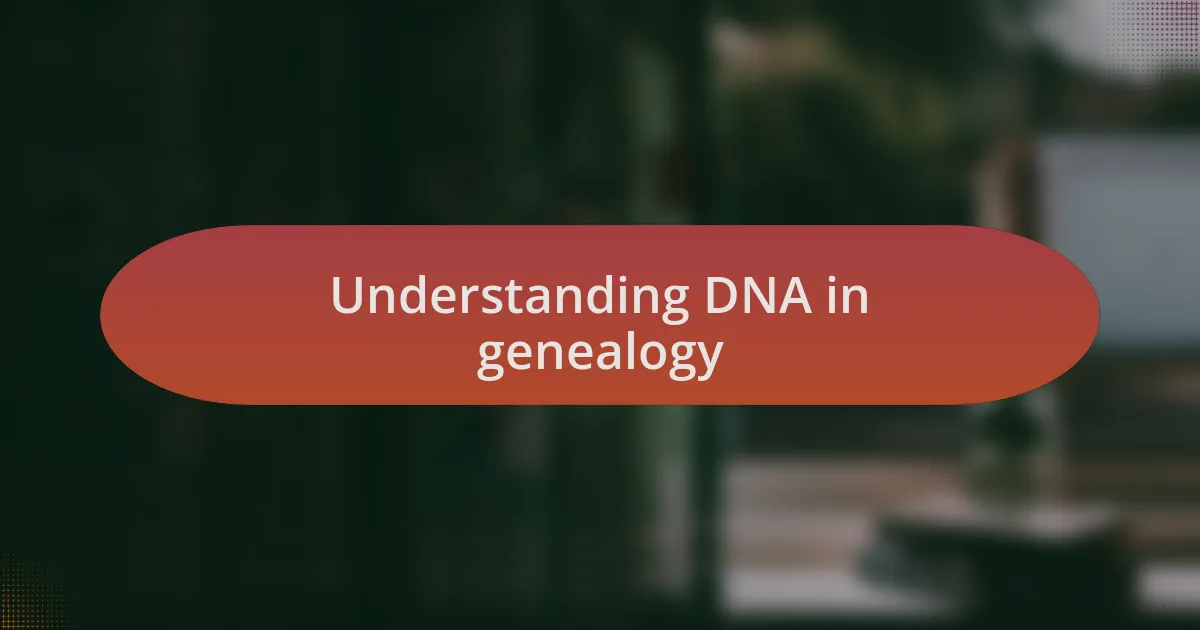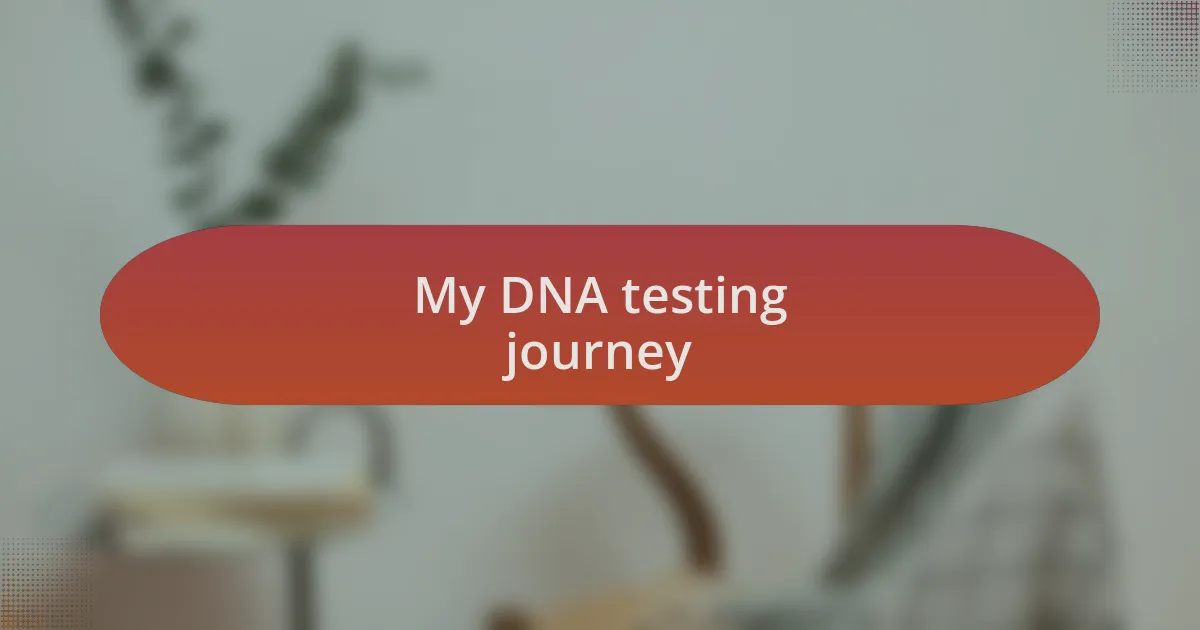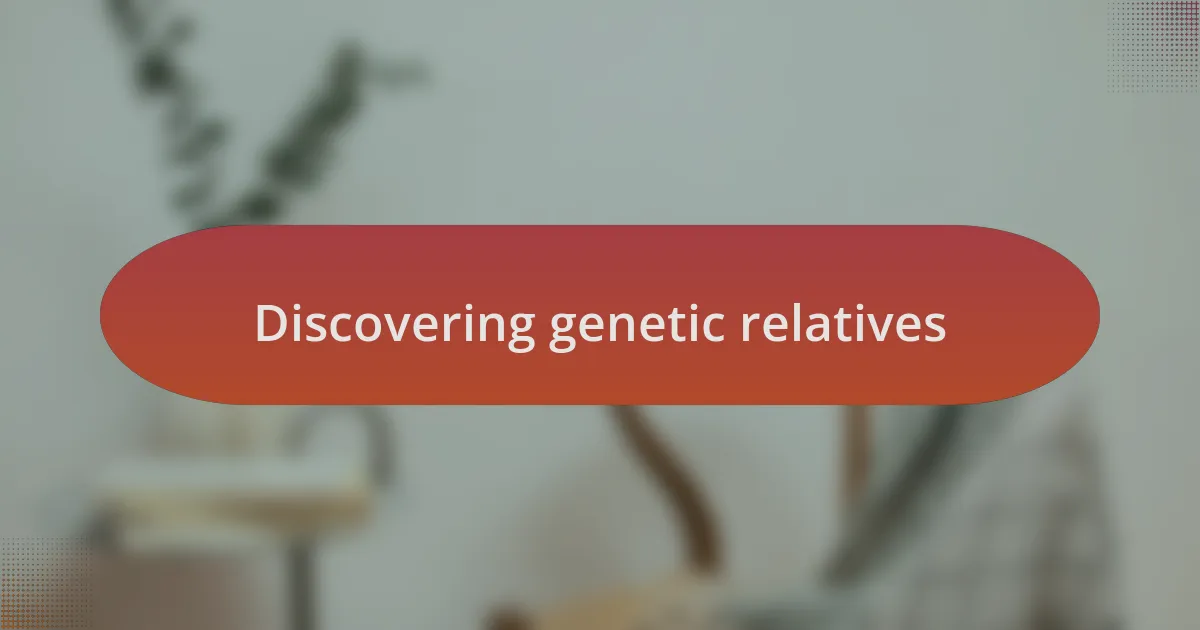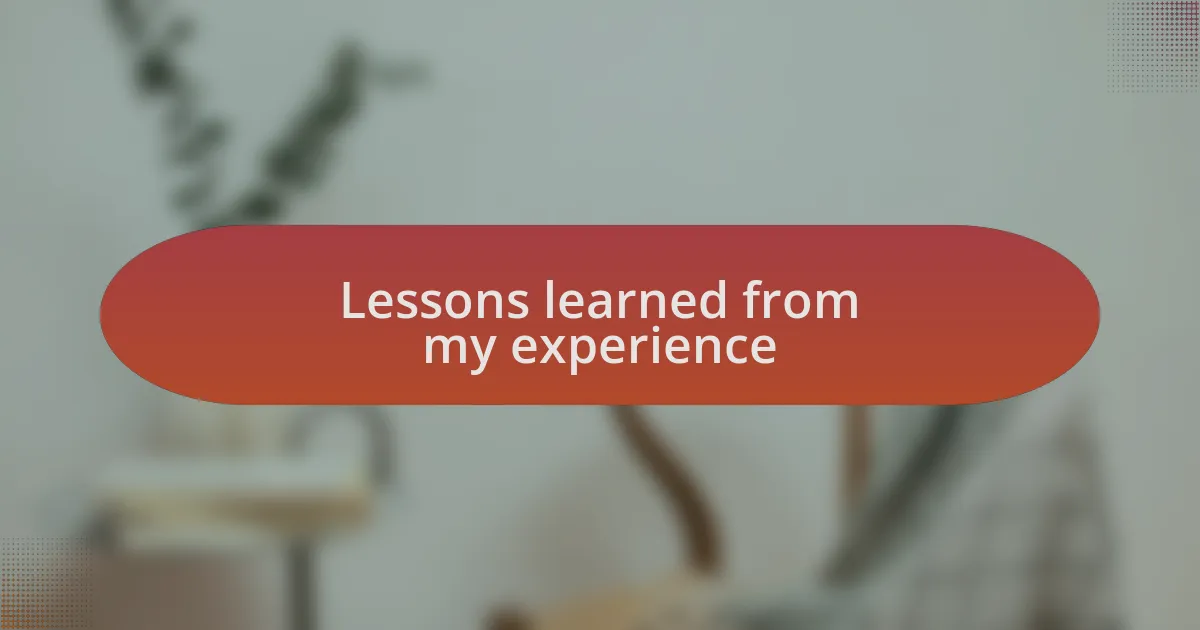Key takeaways:
- DNA testing reveals unexpected family connections, enhancing the understanding of personal ancestry and shared histories.
- Tools like AncestryDNA, 23andMe, and GEDmatch facilitate collaborative genealogy research and uncover intricate family narratives.
- Discovering genetic relatives can deepen emotional connections and illuminate the complexities of family dynamics.
- Engaging with newfound relatives prompts reflections on identity, shared traits, and the influence of ancestors on present lives.

Understanding DNA in genealogy
Understanding DNA in genealogy opens up a fascinating world of discovery. When I first delved into my own ancestral roots, the complexity of DNA testing amazed me. The idea that a simple test could unveil generations of family history felt almost like magic.
Each genetic marker tells a story, connecting us to people and places we’ve never known. I remember the thrill of finding that I had distant relatives I never imagined existed. Have you ever wondered how a sliver of DNA could link you to a lineage stretching back centuries? It’s a poignant reminder of our shared humanity and the interconnectedness of our experiences.
As I explored these findings, I realized that DNA isn’t just about tracing lines on a family tree; it’s a window into the cultural and geographical tapestry that shapes who we are. There’s something deeply emotional about learning where your great-grandparents came from and understanding the struggles they faced. It makes the past feel alive, doesn’t it? Understanding DNA in genealogy is about piecing together a narrative that’s uniquely yours, filled with the echoes of those who came before you.

Tools for DNA integration
When it comes to integrating DNA findings into your genealogy research, tools like AncestryDNA and 23andMe are invaluable. I remember using AncestryDNA and being amazed to see my ethnic breakdown alongside a list of potential relatives. Did you know that these platforms not only provide you with raw DNA data but also connect you with individuals who share segments of DNA? It transforms research from a solitary task into a collaborative exploration of shared histories.
Another powerful tool I often recommend is GEDmatch, which allows users to upload their raw DNA data from various testing companies. I found it particularly fascinating when I matched with a distant cousin and we collaborated to fill in gaps in our family trees. Have you ever thought how surprising it can be to discover a connection you never knew existed? That moment of realization emphasized how interconnected our stories are, reinforcing the idea that our journeys in genealogy are far from solitary.
Finally, utilizing chromosome browsers, like the one offered by FamilyTreeDNA, enhances your comprehension of genetic relationships. Analyzing which segments of DNA you share with relatives can provide deeper insights into shared ancestry. I recall being thrilled when I could visually trace segments back to specific ancestors, revealing patterns I hadn’t expected. This level of detail can be so enlightening; it begs the question, how much of our story is waiting to be uncovered with the right tools?

My DNA testing journey
My DNA testing journey began with a mix of excitement and uncertainty. I vividly recall unsealing the package and feeling a sense of anticipation as I prepared to send off my sample. At that moment, I couldn’t help but wonder: what secrets lay hidden in my genetic makeup? It felt like embarking on a treasure hunt where the prize could unveil my family’s history.
When the results finally arrived, I was both amazed and somewhat overwhelmed by the findings. For instance, discovering that I had unexpected ties to regions I had never considered made me think about the broader tapestry of my ancestry. It was like unlocking a door to a past filled with stories I never knew existed, and that realization filled me with an exhilarating curiosity. How could a single test connect me to far-flung corners of the world?
As I delved deeper into the matches provided, I found moments of pure serendipity. Connecting with a cousin I’d never met was a highlight, as we pieced together our family narrative over countless conversations. I learned that these tests do more than reveal data; they create opportunities for bonding and shared experiences. It made me ponder, how many more connections are out there, waiting for us to find them?

Discovering genetic relatives
As I explored my DNA results, a message popped up indicating a genetic match with someone who shared my great-great-grandparents. Can you imagine the thrill? I instantly reached out, and the connection led to endless conversations about family traditions and lost histories. Suddenly, those faded photographs of ancestors took on vibrant new stories filled with lives I had never imagined.
In one of our chats, my newfound cousin shared how she had always felt a pull towards the town my ancestors once called home. That resonated with me deeply; I had often sensed a strange familiarity in places I had never visited. It made me question—how much of our identity is shaped not just by the stories we know, but by the bloodlines that connect us to those we’ve never met?
Over time, I found myself attending a family reunion organized by some of these genetic relatives. Surrounded by people who looked like me, I felt a sense of belonging that was both heartwarming and surreal. It made clear to me that taking that DNA test wasn’t just about numbers or percentages; it was about intertwining lives and rediscovering the roots that bind us together throughout generations.

Lessons learned from my experience
I quickly learned that DNA findings can shift one’s understanding of family dynamics. I remember feeling a mix of excitement and anxiety when I uncovered unexpected connections that challenged my pre-existing narratives. How could someone so closely related to me live an entirely different life? This realization showed me that our families can be much more complex than the stories we’ve been told.
Another lesson that struck me was the importance of keeping an open mind. A few of my genetic matches didn’t fit the typical mold of family I had envisioned. When I met a cousin whose life experiences diverged wildly from mine, I discovered shared traits in our passions, like a love for music. It made me ponder—what if our bonds truly extend beyond mere blood relations into the essence of who we are?
Perhaps one of the most profound lessons was the emotional landscape that emerged from these discoveries. One particular conversation with a distant relative brought tears to my eyes as we shared stories of family hardships and resilience. It became evident how the past influences our present, igniting a deeper appreciation for the sacrifices of those who came before us. Isn’t it fascinating how DNA can forge connections that help us heal old wounds and understand ourselves better?